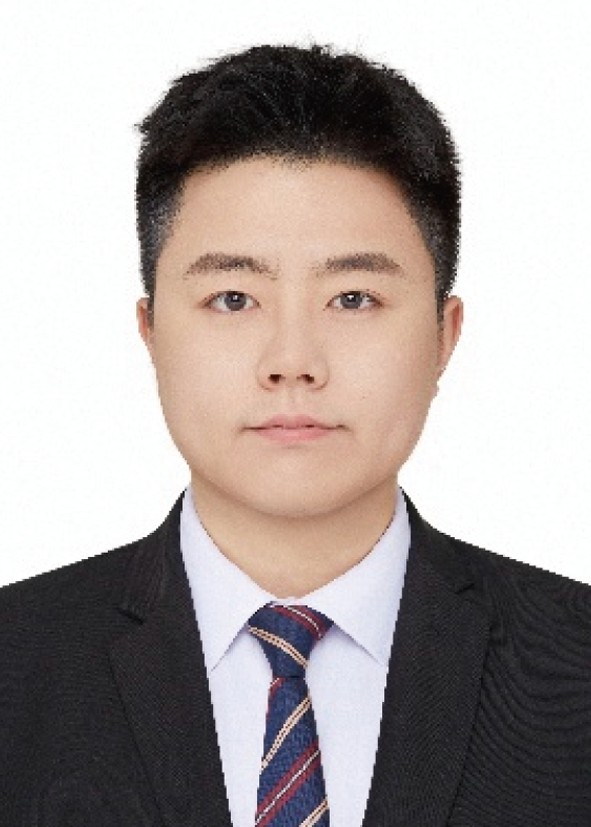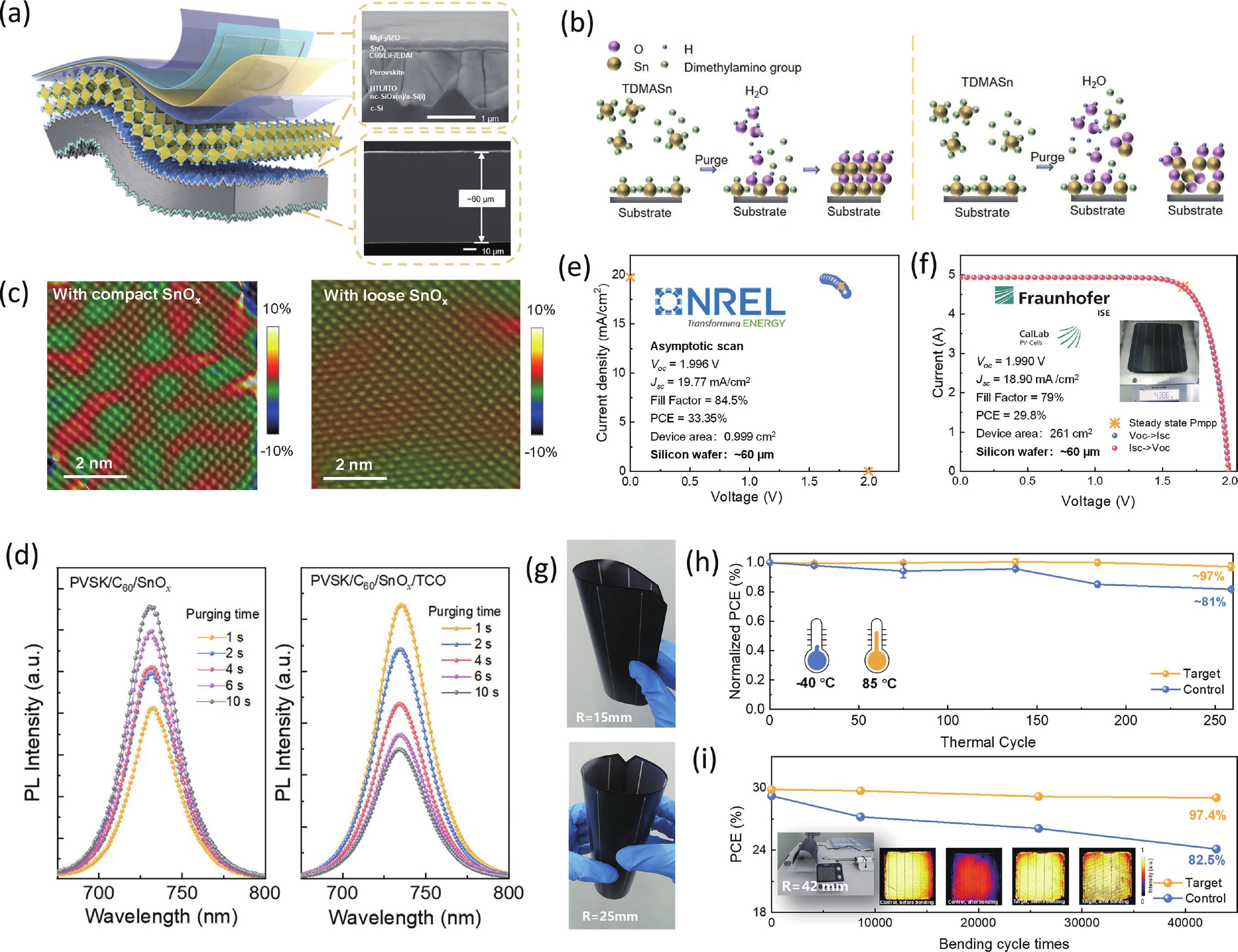| Citation: |
Zhaoyang Han, Qi Jiang. Advancing highly efficient and mechanically resilient flexible perovskite-silicon tandem solar cells[J]. Journal of Semiconductors, 2025, 46(12): 120401. doi: 10.1088/1674-4926/25110013
****
Z Y Han and Q Jiang, Advancing highly efficient and mechanically resilient flexible perovskite-silicon tandem solar cells[J]. J. Semicond., 2025, 46(12), 120401 doi: 10.1088/1674-4926/25110013
|
Advancing highly efficient and mechanically resilient flexible perovskite-silicon tandem solar cells
DOI: 10.1088/1674-4926/25110013
CSTR: 10.1088/1674-4926/25110013
More Information-
References
[1] Werner J, Niesen B, Ballif C. Perovskite/silicon tandem solar cells: Marriage of convenience or true love story? −An overview. Adv Materials Inter, 2018, 5, 1700731 doi: 10.1002/admi.201700731[2] Yang G, Deng C Y, Li C W, et al. Towards efficient, scalable and stable perovskite/silicon tandem solar cells. Nat Photonics, 2025, 19, 913 doi: 10.1038/s41566-025-01732-y[3] Leijtens T, Bush K A, Prasanna R, et al. Opportunities and challenges for tandem solar cells using metal halide perovskite semiconductors. Nat Energy, 2018, 3(10), 828 doi: 10.1038/s41560-018-0190-4[4] Wang Z, Han Z, Chu X, et al. Regulation of wide bandgap perovskite by rubidium thiocyanate for efficient silicon/perovskite tandem solar cells. Adv Mater, 2024, 36(50), 2407681 doi: 10.1002/adma.202407681[5] Ugur E, Ali Said A, Dally P, et al. Enhanced cation interaction in perovskites for efficient tandem solar cells with silicon. Science, 2024, 385(6708), 533 doi: 10.1126/science.adp1621[6] Liu J, He Y C, Ding L, et al. Perovskite/silicon tandem solar cells with bilayer interface passivation. Nature, 2024, 635(8039), 596 doi: 10.1038/s41586-024-07997-7[7] Jia L B, Xia S M, Li J, et al. Efficient perovskite/silicon tandem with asymmetric self-assembly molecule. Nature, 2025, 644(8078), 912 doi: 10.1038/s41586-025-09333-z[8] Mariotti S, Köhnen E, Scheler F, et al. Interface engineering for high-performance, triple-halide perovskite−silicon tandem solar cells. Science, 2023, 381(6653), 63 doi: 10.1126/science.adf5872[9] Han Z, Wang Z, Xia Z, et al. Uniform phase distribution of wide bandgap perovskite for high-performance perovskite-silicon tandem solar cells. Nat Commun, 2025, https://doi.org/10.1038/s41467-025-66480-7[10] Aydin E, Ugur E, Yildirim B K, et al. Enhanced optoelectronic coupling for perovskite/silicon tandem solar cells. Nature, 2023, 623(7988), 732 doi: 10.1038/s41586-023-06667-4[11] Mailoa J P, Bailie C D, Johlin E C, et al. A 2-terminal perovskite/silicon multijunction solar cell enabled by a silicon tunnel junction. Appl Phys Lett, 2015, 106(12), 121105 doi: 10.1063/1.4914179[12] National Renewable Energy Laboratory (NREL). Best research-cell eifficiency chart. [Accessed: 10 November 2025]. https://www.nrel.gov/pv/cell-efficiency.html[13] Ying Z Q, Yang X, Wang X Z, et al. Towards the 10-year milestone of monolithic perovskite/silicon tandem solar cells. Adv Mater, 2024, 36(37), 2311501 doi: 10.1002/adma.202311501[14] Shockley W, Queisser H J. Detailed balance limit of efficiency of p-n junction solar cells. J Appl Phys, 1961, 32(3), 510 doi: 10.1063/1.1736034[15] Shishido H, Sato R, Ieki D, et al. High-efficiency perovskite/silicon tandem solar cells with flexibility. Sol RRL, 2025, 9(11), 2400899 doi: 10.1002/solr.202400899[16] Huang Z Q, Li L, Wu T Q, et al. Wearable perovskite solar cells by aligned liquid crystal elastomers. Nat Commun, 2023, 14(1), 1204 doi: 10.1038/s41467-023-36938-7[17] Sun Y Q, Li F M, Zhang H, et al. Flexible perovskite/silicon monolithic tandem solar cells approaching 30% efficiency. Nat Commun, 2025, 16(1), 5733 doi: 10.1038/s41467-025-61081-w[18] Wang X L, Zheng J M, Ying Z Q, et al. Ultrathin (~30 µm) flexible monolithic perovskite/silicon tandem solar cell. Sci Bull, 2024, 69(12), 1887 doi: 10.1016/j.scib.2024.04.022[19] Liu W Z, Liu Y J, Yang Z Q, et al. Flexible solar cells based on foldable silicon wafers with blunted edges. Nature, 2023, 617(7962), 717 doi: 10.1038/s41586-023-05921-z[20] Bristow H, Li X L, Babics M, et al. Mitigating delamination in perovskite/silicon tandem solar modules. Sol RRL, 2024, 8(14), 2400289 doi: 10.1002/solr.202400289[21] De Bastiani M, Armaroli G, Jalmood R, et al. Mechanical reliability of fullerene/tin oxide interfaces in monolithic perovskite/silicon tandem cells. ACS Energy Lett, 2022, 7(2), 827 doi: 10.1021/acsenergylett.1c02148[22] Fang Z, Ding L, Yang Y, et al. Flexible perovskite/silicon tandem solar cell with a dual buffer layer. Nature, 2025, https://doi.org/10.1038/s41586-025-09835-w[23] Wang S B, Li W H, Yu C, et al. Flexible perovskite/silicon tandem solar cells with 33.6% efficiency. Nature, 2025, https://doi.org/10.1038/s41586-025-09849-4 -
Proportional views





 Zhaoyang Han is a Ph.D. candidate at the Institute of Semiconductors, Chinese Academy of Sciences and University of Chinese Academy of Sciences. His research focuses on wide bandgap perovskite solar cells and perovskite-silicon tandem solar cells.
Zhaoyang Han is a Ph.D. candidate at the Institute of Semiconductors, Chinese Academy of Sciences and University of Chinese Academy of Sciences. His research focuses on wide bandgap perovskite solar cells and perovskite-silicon tandem solar cells. Qi Jiang is a professor at the Institute of Semiconductors, Chinese Academy of Sciences and the University of Chinese Academy of Sciences. Her research interests include new type semiconductor photoelectronic materials and devices.
Qi Jiang is a professor at the Institute of Semiconductors, Chinese Academy of Sciences and the University of Chinese Academy of Sciences. Her research interests include new type semiconductor photoelectronic materials and devices.
 DownLoad:
DownLoad:















